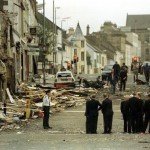
By mid-1997 most Northern Irelanders had accepted the peace process and the need for negotiation and compromise. Radicals on the political fringes, however, showed only contempt for peace negotiations. Loyalist and Republican extremists believed their interests or traditions were being surrendered or sold out by negotiators. Some believed they had been duped by their sworn enemies. Others were pessimistic about the longevity of any agreement, believing it was unrealistic and doomed to fail. Militant paramilitary volunteers wanted to ignore the peace process and continue with the armed struggle. Opposition to the peace process caused more factional splintering within the Provisional IRA. The most significant of these splinter groups, the Real IRA, emerged toward the end of 1997. The Real IRA is best known for car bombing a shopping district in Omagh, County Tyrone, four months after the signing of the Good Friday Agreement. The Omagh bombing killed 29 people, making it the deadliest single attack in the 30-year history of the Troubles.
The split over abstenionism
Irish Republican groups had long been susceptible to factionalism and splintering, usually over strategy and tactics. This was true both of paramilitary groups and political parties. In the mid 1980s Sinn Fein president Gerry Adams embraced the ‘Armalite and ballot box’ strategy, a combination of paramilitary action with political engagement. Not all in Sinn Fein welcomed this. In November 1986 Sinn Fein’s party conference voted to end abstentionism and take up elected seats in the Dáil Éireann, the Republic of Ireland lower house. This tactical shift appalled ultra-Republicans: they considered the Irish parliament an illegally constituted body and wanted no part in it. “Sitting in Leinster House (Dublin’s parliament building) is not a revolutionary activity”, said former Sinn Fein president Ruairí Ó Brádaigh. “Once you go in there [you] will not be able to do it according to your rules.” Led by Ó Brádaigh, around 130 members walked out of the conference in protest. They met to form their own party called Republican Sinn Fein.

The feud over abstentionism also led to the formation of a breakaway paramilitary group. In 1986 pro-abstentionists in the Provisional IRA threatened to break away from the organisation’s Army Council. They received political support from Tom Maguire, a 94-year-old veteran of the Anti-Treaty IRA, and began meeting as the Continuity Army Council. While this faction had the makings of a splinter group, it did not yet proceed that far due to threats from Provisional IRA leaders. That changed following the Provisional IRA’s August 1994 ceasefire. Outraged the Provisional IRA had laid down its weapons, this militant faction vowed to continue the armed struggle. They called themselves the Continuity IRA and claimed a continuous lineage from Tom Maguire’s first IRA. Though small in size, probably with fewer than 100 members, the Continuity IRA mobilised to disrupt the peace process. During the mid to late 1990s the group planted or detonated numerous bombs, usually near Royal Ulster Constabulary (RUC) or government targets. The Continuity IRA is often referred to as the paramilitary wing of Republican Sinn Fein. This is denied by the party leadership, though there are apparent links between the two groups.
The McKevitts and the Real IRA

In a similar fashion, the Provisional IRA’s second ceasefire (July 1997) gave rise to the Real IRA. The instigators were Michael McKevitt and his partner Bernadette Sands McKevitt (sister of hunger striker Bobby Sands). Both opposed the ceasefire and resigned from the Provisional IRA Executive in October 1997. The following month the McKevitts formed their own group, recruiting dissident IRA volunteers who wanted to ignore the ceasefire. They called themselves Óglaigh na hÉireann (“Soldiers of Ireland”), a name often used by militant Republican groups. The press dubbed this group the Real IRA, a phrase used by one of its volunteers. In December 1997 Bernadette Sands McKevitt oversaw the formation of the 32 County Sovereignty Movement (32CSM). The 32CSM was formed as the political wing of the Real IRA, though its members often deny this. As its name suggests, the 32CSM sought to unite the 26 counties of the Republic and the six counties of Northern Ireland into a single independent nation.

In its first weeks, the Real IRA gathered weapons and munitions by raiding Provisional IRA arms dumps (McKevitt, a former Provisional IRA quartermaster, had inside knowledge of these). It also constructed its own weapons, particularly improvised mortars and car bombs made with plastic explosives and fertiliser. The group’s activities were bankrolled with the proceeds of armed robberies and illegal trading. The Real IRA began its armed campaign in January 1998 by planting a car bomb in downtown Banbridge. Over the next eight months, it carried out numerous attacks on RUC buildings or checkpoints, using mortars or bombs. Some of these attacks may have been carried out in conjunction with the Continuity IRA, which was also active during this period. Real IRA volunteers also targeted commercial property by leaving car bombs in shopping and business districts. The detonation of these bombs was always preceded by a telephone warning, allowing time for police to evacuate civilians from the area.
Devastation in Omagh

This tactic soon went horribly awry. On August 1st 1997 the Real IRA bombed Banbridge for a second time, detonating a 500-pound car bomb in the city centre. Telephone warnings were given but the bomb exploded before the area was fully clear and dozens of people were injured. A fortnight later, on August 15th, a car bomb of similar size was planted in a shopping district in Omagh, County Tyrone. The bombers phoned in two warnings – one to a television station, the second to a charity – but gave imprecise details about the location of the bomb. RUC officers acted on the warning by evacuating an area around the local courthouse, unaware they were herding civilians closer to the bomb. The device detonated at 3.10pm, almost 40 minutes after the first warning. The effects were catastrophic. The blast killed 29 people, some of them literally blown to pieces. Six of the dead were children aged 12 and under; another six were teenagers. One woman killed by the blast was pregnant with twins. Among the victims were both Catholics and Protestants, as well as two Spanish tourists. Hospitals in County Tyrone were inundated with more than 200 casualties suffering from blast injuries and severe burns.
“[The Omagh bombing] is designed to wreck the process and everyone should work to ensure the peace process continues as is the clear wish of the people of the island. Sinn Fein has called for a complete halt to such actions and has urged all armed groups to stop immediately… We have to work politically to make the Omagh bombing the last violent incident in our country, the last incident of this kind. We are committed to making conflict a thing of the past.”
Gerry Adams, Sinn Fein leader
The bombing of Omagh caused headlines around the world and invoked universal expressions of sympathy. Leaders of all political hues condemned the bombers and their actions. Nationalist leader John Hume called them “undiluted fascists”; Northern Ireland Secretary of State Mo Mowlam said they were “murderers pure and simple”. Tony Blair promised that those responsible would be “pursued to the utmost”. US president Bill Clinton visited Omagh three weeks after the bombing, inspecting the damage and speaking with victims. Republican leaders Gerry Adams and Martin McGuinness were also unequivocal in their condemnation. Suspicion immediately fell on the Real IRA, due to similarities with the Banbridge bombing a fortnight before. Three days later, the Real IRA claimed responsibility for the bombing and offered an apology for the civilian deaths and casualties. The group’s statement said the Omagh bomb was targeted at commercial properties and no civilian casualties were intended. The Real IRA also defended its operations, claiming to have issued three specific warnings about the location of the bomb.
The impact of Omagh

The Omagh bombing sparked concerns that the Good Friday Agreement would be derailed – but if anything the suffering in Omagh only strengthened the resolve for peace in Northern Ireland. The outpouring of public grief and condemnation forced radical Republican groups to reassess their strategy. On August 22nd, a week after the bombing, the Irish National Liberation Army (INLA) – which has been accused of supplying and possibly assisting the Real IRA at Omagh – announced a unilateral ceasefire. This ceasefire effectively ended the INLA as a Republican paramilitary group. The Real IRA declared its own ceasefire on September 8th, after McKevitt and others were subjected to hostile pressure. In late 2000 McKevitt was deposed as leader of the Real IRA. The group remained active in 2000 and beyond, though it never again hit civilian targets or operated so indiscriminately. Investigations into the Omagh bombing identified numerous suspects, made several arrests and laid criminal charges against three men. Real IRA member Seamus Daly was charged with 29 counts of murder in 2014 but released in 2016 due to contradictory evidence. To date, nobody has been convicted or served prison time. The motion picture Omagh, released in 2004, depicts both the bombing and the frustration of victims as they search for answers and justice. In 2009 the families of all 29 Omagh victims won a civil action against McKevitt and four other Real IRA volunteers; they were awarded damages of £1.6 million.

1. The decentralised nature of Republican groups, along with frequent debates over strategy and tactics, led to the creation of splinter or breakaway groups.
2. Sinn Fein’s 1986 decision to wind back abstentionism triggered a split in the party. This led to the formation of Republican Sinn Fein and, later, the Continuity IRA.
3. The Real IRA and its political wing, the 32 County Sovereignty Movement, were formed in late 1997, in response to the Provisional IRA’s second ceasefire.
4. The Real IRA launched a campaign of terrorism that culminated in the bombing of Omagh on August 15th 1998. This was the worst single attack of the Troubles, killing 29 civilians.
5. Despite extensive investigation, numerous arrests and charges against three men, no individual has been brought to justice for the deaths of 29 people in downtown Omagh.

The Real IRA newspaper condemns the Provisional IRA for decommissioning (December 2001)
US State Department report on the Real IRA (April 2008)
© Alpha History 2017. Content on this page may not be republished or distributed without permission. For more information please refer to our Terms of Use.
This page was written by Rebekah Poole and Steve Thompson. To reference this page, use the following citation:
R. Poole and S. Thompson, “The Real IRA and Omagh”, Alpha History, accessed [today’s date], https://alphahistory.com/northernireland/real-ira-omagh/.
